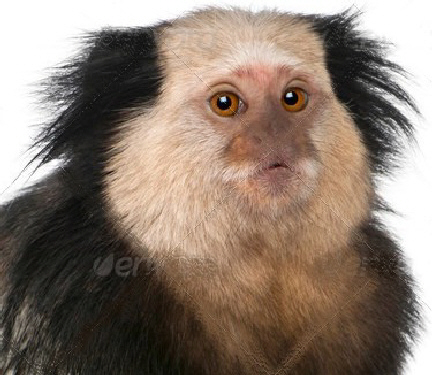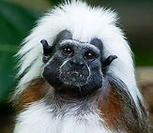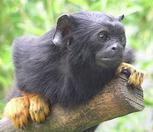What is a CALLITRICHID?
Marmosets and Tamarins are a type of monkey. They are several species of marmosets and tamarins in the genus Callithrix. Marmosets have distinctive large ear tufts and their tail is striped, with alternate wide dark and narrow pale bands. Their coat is grey, black, brown and white with streaks of orange.
Originating in the Atlantic Coastal Forest in Northeast Brazil they have also been introduced to some parts of South East Brazil, including some urban areas. They are arboreal and weigh less than a can of baked beans. Claw-like nails allow them to cling to trees.
In the wild they live in small family groups of 3-15 individuals. Their day is spent socializing, finding and feeding on gum, insects, lizards, snails, fruit, flowers and nectar while staying alert to danger.
ENRICHMENT
What is Enrichment?
Enrichment aims to improve welfare in captive animals.
It is a type of Refinement that involves identifying and providing stimuli that enhance the state of well-being of marmosets and other animals. Enrichment is important for both physical and psychological health. There are several key concepts relating to enrichment including: encouraging natural behavior, increasing complexity and choice while allowing control, novelty and movement.
Encourage Natural Behavior
The captive environment should allow marmosets to express the full range of natural behavior shown in the wild, including:
All positive locomotory behaviors and postures: leaping, running, climbing, clinging, hanging upside-down etc.
All social activities: grooming one another, resting, playing and huddling etc.
Food-finding behavior: capturing insects, gnawing trees for gum and working hard to get at and into fruits and other foods
The opportunity to explore novel items and environments
A safe, comfortable place to sleep and hide.
Introduce Complexity
Complexity provides choice. Choice allows a degree of control and reduces the likelihood of boredom. Marmosets can only choose if they have a range of options presented to them. Complexity can be introduced through ‘enrichment’ in a variety of complementary ways. Enabling an active but harmonious social life. Changing their physical environment. Providing an appropriate variety of food in ways that present a challenge to reach it . Activities that challenge their minds and stimulate their senses. Movement of objects, structures or live animals can be enriching. Movement attracts attention and introduces unpredictability, for example: swings to move and play on, loose objects like feathers to play with, live insects to chase, views through windows of live birds, etc.
Novelty and change reduce boredom. Marmosets quickly lose interest in some items. Frequent changes made to the enrichment can sustain attention and interaction. A rotation ‘timetable’ can be arranged so that different options are made available in turn, cycling through enrichment items then becomes easy and automatic for caregivers.
Control
Keep in mind, however, that excessive and swift change can be overwhelming (i.e. negative for welfare)
It is important that marmosets have as much control as possible. Control is linked to predictability and so reduces stress
While having the opportunity to explore a variety of objects and situations, marmosets should always have the option of removing themselves from the stimuli.
Evaluation and Safety
It is necessary to evaluate whether or not enrichment has improved welfare. Some enrichment options will work better than others, some will not be effective at all, and some may have unexpected negative effects. Safety is an important consideration when adding architecture or objects to an enclosure.
Social Enrichment
Contact Social Enrichment. Marmosets are highly social creatures. Companionship is of vital importance to their welfare
Social Housing
Housing marmosets with other marmosets can be good for welfare.
Allow marmosets to perform species-typical social behaviors that are important for well-being (grooming, licking and nuzzling, huddling, resting and playing.). Enable good social development
Buffer marmosets against the effects of stressful events.
Non-contact Social Enrichment
As well as contact social enrichment, marmosets also benefit from social enrichment that does not involve direct contact with other marmosets– e.g. responding to the smells or calls of other marmosets
Olfactory: Smell A log that has been scent marked by marmosets in another group can be placed in the enclosure
Auditory: Audio recordings of amicable calls made by other marmosets An ipod, attached to a mini-speaker, plays marmoset chirp calls inside a covered box
Visual: Video recordings of other marmosets engaged in amicable behavior Marmosets can watch video, displayed on a computer monitor
Housing
Walk-in Enclosure
Allows marmosets to remain above head height
Large space and enclosure furnishings allow natural locomotory behavious such as leaping
Small enclosures can have severe welfare consequences BUT extra space is no use without complex architecture
Climate
Marmosets are tropical monkeys and require:
- Surrounding temperature of 23-28 °C
- Humidity level of 40-70%
Marmosets will choose to go outside in cold weather, but it is critical they can return to the warmth if they wish
should not be allowed out when it is very cold as they have been known to get frostbite (guideline min. temp: 5 °C)
Cleaning
Clean, hygienic conditions are necessary
Stale food and excreta need to be removed regularly
A thorough cleaning of the enclosure should only be done at least once a month
Scent marking is important to the marmosets and cleaning should not remove familiar scents completely
Feeding & Diet
In the Wild Marmosets have a very varied diet. They feed in the early morning and early afternoon. At least half their day is spent foraging for food. They have to work very hard to get their food: chasing and catching insects, gnawing at trees for gum,
searching for fruiting trees using their memory to help find them climbing and hanging down to reach the fruits and then getting through the tough outer skin to the fruit inside.
In Captivity
In captivity, marmosets need to be provided with a range of appetising and nutritious food. Marmosets are selective eaters
Feeding affects growth, disease resistance, lifespan, and susceptibility to stress .
Commercially available dry pellets containing the necessary nutritional components of their diet should be supplemented with a variety of other foods:
fresh and dried fruit
vegetables
seeds and nuts
animal protein (e.g. insects, mealworms, boiled chicken and hard boiled eggs)
Marmosets should also have access to as much water as they wish to drink
Vitamin D3 should be given as a supplement as the marmosets cannot make it in their own body
Feed marmosets several times a day to match their natural eating times
Provide food in several food dishes, and water in several places
Place the food dishes at least a 4 feet above the ground (marmosets prefer to feed and eat higher up where they feel safer)
Food Enrichment
Food should be presented to the marmosets in a way that encourages their natural food finding behavior: foraging, gnawing, catching insects, finding, reaching and getting into fruit.
Introducing new foods and novel textures stimulates the marmosets’ curiosity and interest.
Artificial Gum
Providing artificial gum inside hanging film canisters and bamboo tubes encourages the marmosets to work to get to it
Gum arabic can be used as a substitute for tree gum in the wild.
Live Insects
Live insects attract lots of attention. Marmosets chase, stalk and pounce on them. Some are more experienced at catching insects than others. Insects that can be safely introduced include: crickets, grasshoppers, and locusts
Live Mealworms
Mixing live mealworms into the sawdust, or other substrate, encourages foraging behavior
Unprocessed/Whole Food
Food is often chopped up. However, leaving skin on bananas, apples or other fruits or giving peanuts in their shells increases the time taken, and effort required to get to the food inside. Food should first be washed thoroughly to remove any pesticides.
Hanging Whole Fruits
Fruit (e.g. banana; apple; orange) can be hung, whole or in segments using non-bleached string and speared with bamboo skewers
In the wild marmosets have to hang upside down to feed on dangling fruits and flowers
Enrichment of this kind encourages this natural behavior
The fruits swing around, providing a challenge to the marmosets as they attempt to reach the food and requiring them to balance
Frozen Fruit Juice
Fruit juice can be frozen, in plastic cups to create hanging or standing ‘lollies’
Food frozen inside can be picked out as the juice melts
Novel Foods
For example: mini-corn; pomegranate; mango; peppers
Some novel foods quickly become popular while some are as swiftly ignored!
Novelty: Frozen Banana
A whole peeled banana can be lightly frozen and introduced as a novelty
The banana is of an unexpected temperature and texture, which changes as the banana slowly warms to room temperature
Soaked Pellets
Dry pellets can be made more attractive to the marmosets by changing their texture. This can be done by soaking dry pellets in a tray with: diluted fruit squash drink: gives taste and softens the texture
fruit jelly mix: gives taste and a gummy, pliant texture
Scatter Feeding
To promote foraging behavior, dry food can be mixed into the floor substrate
Scatter feed mix can also be placed in an elevated box to allow foraging higher up where marmosets are more active.
Activity
Food Finding Activities
Marmosets can get bored if food is quick to find. Boredom is a problem because it can lead to a reduction in welfare through increased stress and abnormal behaviors. In the wild a lot of their day is spent foraging for food. Marmosets enjoy working for their food.
Film Canisters on Board
Film canisters, with lid half-on and containing fruit, provide a challenge
Canisters can be fixed to plastic board using plastic cable ties
Egg Box
An egg box filled with sawdust and treats can be tied to a solid surface, using bleach-free string
Forage Box
A plastic box can also be baited with food
Hamster Wheel
Food placed into a hamster wheel moves when marmosets jump in to reach it
As the wheel moves underneath their feet they use their tails for balance
The wheel is restricted in movement: a very important safety measure to ensure that the tail cannot be trapped in the wheel
Hanging Film Canisters
Empty films canisters hanging upright with treats inside require gymnastics to reach
Fill with artificial gum; mashed banana; raisins
Stuffed Toilet Roll
Food can be hidden inside an empty toilet roll stuffed with crumpled bits of bleach-free paper or straw.
Food Hidden in Hanging Architecture
Food hidden in hanging structures encourages exploration and requires balance to reach
Encouraging Play
Play can be encouraged by placing novel objects into the enclosure
Care should be taken to ensure that such novel objects do not present any safety risks (avoid risk of choking, strangling, etc.)
Items soft in texture, warm to touch, and with folds in which to hide are particularly effective
Marmosets enjoy the feel of the material and this encourages them to touch it and to relax and roll around on it
Cat Basket
A soft fleece-lined cats basket provides somewhere to hide and wrestle
Objects on the floor can tempt marmosets down so that this under-used area of the enclosure is used (however, remember that
marmosets prefer to spend their time high up being arboreal)
The unexpected ‘give’ in the basket roof when a marmoset leaps demands quick balancing
Tea-towel Hammock
Tie each end of a tea towel with un-bleached string and suspend high above floor
Cheap, easy way to provide movement and a soft-textured, place to sit high up
Feathers in Box
A box of loose feathers provides a soft place in which to wrestle and play
Loose feathers can be carried around by marmosets because they weigh little
They can move in an unpredictable way
Fleece Pillow-case
A fleece pillow case offers a soft texture and encourages the marmosets to play
They can hide in the soft folds of the material
Other Activities to keep marmosets busy
Remote-controlled Toys
The introduction and especially the movement of a toy initially attracts attention and investigation
Sounds of Other Animals
Can be played to marmosets to provide auditory enrichment
Marmosets are likely to attend to the noise and may approach the source
Mirror
Marmosets are not thought to be able to recognise the image in the mirror as themselves
They may see the image in the mirror as another marmoset
Mirrors provide unexpected views that fascinate marmosets
Novel Object
Novelty is important to keep attention high
They will need to feel in control and run away from it if they begin to feel uncertain or threatened
Marmosets and Humans
Human caregivers are an extremely important factor in the well-being of captive marmosets
Humans can have a positive or negative effect on marmosets
Developing and maintaining a positive relationship with marmosets helps them to deal better with stressful events involving humans and is rewarding in return
Humans Viewed as a Threat
Humans can be viewed as predators by marmosets, especially if they become associated with negative events
If so, marmosets may become nervous, highly alert and vigilant and be easily stressed and agitated in your presence
Behavior that indicates your marmosets view you as a threat includes: anogenital tail present, alarm-calling (ek, tsik, seeps and particularly the mobbing call), their hair fluffing/bristling up (piloerection), agitated, ‘nervy’ locomotion and mobbing behavior
Humans Viewed as a Positive Part of the Environment
Marmosets that have got used to you, and view you as a neutral or positive presence, will display: relaxed calm locomotion, carry out positive behaviors such as allogrooming, resting and play, and will be relatively silent (apart from the quiet whirr call) while you are around them
Bear in mind that a change of hair color, perfume, etc. may mean that the marmosets do not recognize you and may respond as so.
Marmosets/Tamarins and You
Both marmosets/tamarins and caregiver can benefit from developing a positive relationship
Captive marmosets need to be shown that humans are an important, pleasant, part of their environment through ‘socialization’
Socialization allows a marmoset to become used to you being close to them and them with you.
Handling and Training
Handling can cause distress to marmosets.
To avoid distress these procedures using a technique called ‘Positive Reinforcement Training’. This Training can also lead to other benefits, including reduced levels of stress and boredom for the marmosets, and an improved relationship between caregiver and marmosets.
Handling
Marmosets do not like to be held down any way
They should only be held down if there is no alternative and only if it is absolutely necessary as with veterinary work or medications.
Disadvantages
Handling can cause fear and distress to marmosets.
Stress and upset may last for some time after handling has ended
Anticipation of being handled can also cause agitation and anxiety
Capture in nets or gloves can lead to injuries in the marmosets
Marmosets can get tangled in nets, or hurt while being chased
Marmosets tightly gripping mesh can damage their clawlike nails if forcibly removed
It is very important that marmosets have a place inside which they can always feel safe and secure
Recommended Handling Procedure
It is possible for marmosets to get used to being handle for precedures with a lot of patience and time is spent gradually desensitising them using small treat foods
Hold the part of the tail nearest the body with the other hand around the shoulders, supporting their weight and keeping them upright
Be firm but gentle, lower your voice and move slowly and calmly, without sudden movements
Only hold with a tea towel or wash cloth. Something other then your bare hand.
Training
Through a technique called positive reinforcement training (PRT)
Marmosets can be trained to cooperate with unplesant procedures
What is Positive Reinforcement Training?
Marmosets are given positive rewards (positive reinforcement) in response to the performance of a certain desired behavior
Particular behaviors that are consistently paired with receiving a small food reward are more likely to be performed again
Offering Food. Is the first step of any training program
Initial approaches can be reinforced with rewards
Suitably tiny portions of rewards (e.g. small bits of grape, raisin, marshmallow, banana chip or gum arabic)
Time and Training
Training does take some initial time investment, but surprisingly little
Marmosets take different amounts of time to learn
However, if marmosets are willing to accept food, they will take less time to train
Once trained to do something, marmosets will remember for long periods of time
Advantages of Training
Helps to create good relationships /improve the relationship between marmosets and their caregivers
Reduces stress
Provides an enriching challenge to marmosets
Marmosets can be trained to hold a target for some seconds for a food reward whilst they hold the target
They remain in one place, close to you, allowing their collar to be quickly cleaned
Important: training done badly is even worse than when no training is done at all. It is essential to learn the correct techniques.
As highly intelligent and inquisitive creatures, marmosets can get easily bored, which causes stress
They need to be regularly provided with challenges, activities, and new objects to investigate
Health
Veterinary Care
Veterinary surgeons require specialist training to deal with marmosets. Not all veterinary surgeons will have had this training.
Locate and make contact with a specialist veterinary surgeon before they are needed.
Health Checks
Marmosets should be checked by a vet at least once a year
Signs of Illness
Weight loss
Coat looks duller or shows signs of lack of grooming
Marmoset is sitting alone
Hunched posture
Loss of appetite or not drinking
Not climbing or jumping
Lack of energy or alertness
Any non-normal behavior or other signs of ill health
Abnormal Behaviors
Stereotypical Behavior
Repeated circling and weaving behavior
Usually occurs when enclosure is too small, so provide more space
Serious negative welfare indicator
Self-injurious Behavior
Excessive self-scratching picking at their hair, biting self, etc.
Serious negative welfare indicator that requires veterinary intervention
Marmosets/Tamarins are not a suitable pet for everyone.
They do NOT do well with young children or people that work a lot.
Common Marmoset Penicillata Marmoset Geoffrey Marmoset Cotton Top Tamarin Red Handed Tamarin Geoffrey Tamarin
White Tufted Black Tufted White Faced
(Callithrix jacchus) (Callithrix penicillata) (Callithrix geoffroyi) (Saguinus oedipus) (Saguinus midas) (Saguinus geoffroyi)




